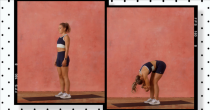
Welcome to our weekly Move of the Week series. Every Monday, we’ll be sharing with you one of our favourite exercises – how to do them, what muscles they work and why they should be a regular part of your workout regime. This week: ragdoll.
When you’re feeling stiff from a long night’s sleep or an equally long day at the desk, you need a dynamic pose that will get the blood flowing and decompress the spine. The best move for that is the ragdoll stretch, one of yoga’s most underrated postures for shaking off the day or night.
You may also like
Move of the week: puppy dog pose eases a stiff upper back and tight chest
What is a ragdoll stretch?
The ragdoll pose feels incredible for the back of the body, but it’s such a simple pose: it just requires you to drop your torso and head over your legs.
The exercise is great because:
It decompresses the spine: by folding forward you elongate the back, helping to create space through the vertebra that can be compressed from a day of sitting or a night of sleeping.
It can help energise you: as it’s an inversion, where your head is over your heart, it stimulates energising blood flow.
It’s dynamic: the body responds best to movement, rather than static stretches, first thing in the morning.
What muscles does ragdoll work?
A ragdoll mainly works the back of the body, including:
- Upper back
- Lats (side of the back)
- Rear delts (back of the shoulders)
- Erector spinae (the muscles that run either side of the spine)
- Glutes
- Hamstrings
- Calves
You may also like
Reverse lunge your way to injury-proof key running muscles
How to do a ragdoll pose
- Start standing, with your feet grounded into the floor and head upright
- Slowly roll the spine down, hinging at the hips to allow your upper body to fall over your legs
- Have a slight bend in the knee if it feels too intense on your hamstrings – you want your upper body to be floppy and loose
- Take your elbows in the opposite hand and slowly move from side to side, let your head twist to release the neck muscles too
- Slowly roll back up to standing
Images: Stylist
Source: Read Full Article